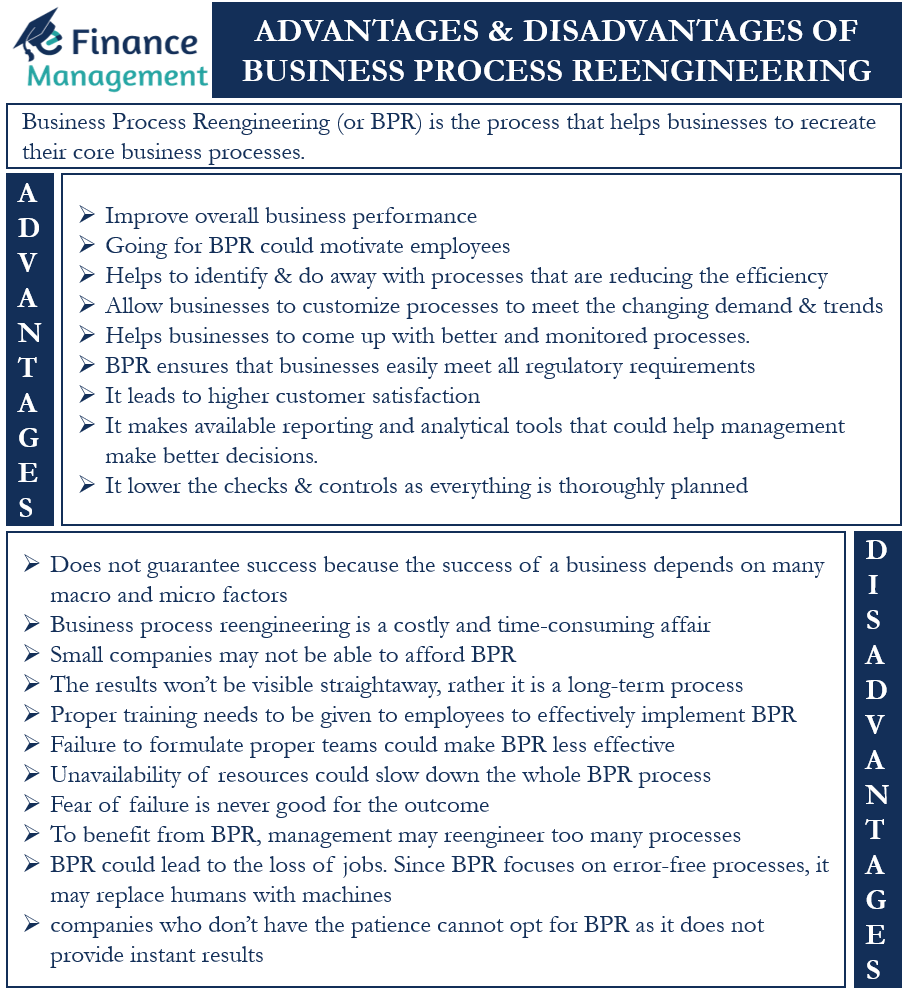Business Process Reengineering (or BPR) is the process that helps businesses to recreate their core business processes. The primary objective of BPR is to improve the quality of products or services, as well as reduce cost and wastage. BPR basically involves analyzing the current business processes to find processes that aren’t meeting the requirements or are inefficient. Also, it helps to make necessary changes to outdated processes, or replace them completely with new and efficient ones. BPR no doubt is beneficial, but like with any other thing, it is not without disadvantages. In this article, we will take a look at the advantages and disadvantages of business process reengineering (BPR).
Advantages of Business Process Reengineering
The following are the advantages of business process reengineering:
Business Performance
Improving overall business performance is the biggest advantage of BPR. As said above, BPR helps to make processes more efficient. This, in turn, helps to boost productivity, employee morale, as well as the bottom line.
Motivation in Employees
A lack of change could make employees dull, or we can say they could get bored. So, going for BPR could motivate employees that they will now be handling processes that are more efficient. This would give them more job satisfaction, and in turn, make them more efficient.
Boosting Productivity
BPR helps to identify and do away with processes that are reducing the efficiency of different departments. This way, it helps to eliminate inefficiency and boost productivity. It makes the company more knowledgeable about its processes.
Flexibility
BPR makes a business flexible. This means it plans the processes in such a way that it gets easy to make changes to them at minimum costs. Or, BPR allows businesses to customize the processes to meet the changing demand and trends.
Risk Reduction
It helps businesses to come up with better and monitored processes. This, in turn, helps to lower operational risks, such as fraud.
Transparency
Using BPR ensures that businesses easily meet all regulatory requirements, as well as remain transparent. This is because BPR integrates regulatory requirements into the processes. And, this automatically makes the processes transparent to all stakeholders.
Customer Satisfaction
It leads to higher customer satisfaction. When processes are efficient and employees are happy, it would automatically results in better customer satisfaction. Since BPR focuses more on processes, it is able to interconnect different functional areas by cutting across the value chain. This, in turn, boosts overall customer satisfaction.
Better Decision-making
BPR makes available reporting and analytical tools that could help management make better decisions.
Better Control
Helps to lower the number of checks and controls as everything is thoroughly planned and duplication is eliminated.

Disadvantages of Business Process Reengineering
The following are the disadvantages of business process reengineering:
No Guarantee of Success
Adopting BPR is no guarantee that a business will be successful. This is because the success of a business depends on many macro and micro factors.
Also Read: Business Process Reengineering
Costly Process
Business process reengineering is a costly and time-consuming affair. This is because BPR involves making big changes at the strategic and operational levels. It won’t be wrong to say that small companies may not be able to afford BPR.
Long-term Process
The results of BPR won’t be visible straightaway, rather it is a long-term process. Or, we can say that result of BPR will show in the long term only. This again makes BPR out of the reach of many companies who don’t have the patience and money to carry ahead with BPR.
Requires Proper Training
Proper training needs to be given to employees to effectively implement BPR. Employees must get training on when and how to implement the new processes. If employees don’t get proper training, it could derail the whole plan.
It is very important to properly structure teams for various process reengineering tasks. Each team must have at least one manager who is an expert in business processes. Failure to formulate proper teams could make BPR less effective.
Unavailability of Resources
Businesses need to come up with the right resources at the right time to implement BPR successfully. The resources could be human resources, funds, process reengineering tools, data, and more. If one or more of these resources aren’t available when needed for BPR, it could slow down the whole BPR process.
Excess Fear & Excitement
Fear of failure is never good for the outcome, and the same is the case with BPR as well. If employees fear that the BPR could fail, then they may be hesitant to take the risk that is needed for the successful BPR implementation.
There are chances that in excitement to benefit from BPR, management may re-engineer too many processes.
Loss of Jobs
BPR could lead to the loss of jobs. Since BPR focuses on error-free processes, it may replace humans with machines.
Final Words
The above advantages and disadvantages of business process reengineering (BPR) make it clear that BPR is not an easy process. Effectively implementing BPR requires a lot of planning, as well as the willingness of top management and support from employees. So, it is very important for a company going for BPR to get itself familiar not just with the advantages but with the disadvantages of BPR as well.

